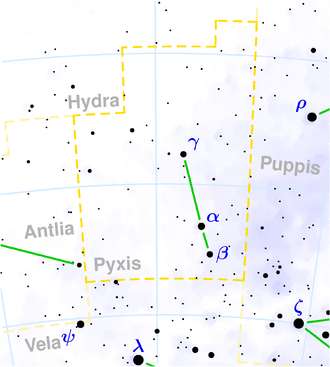NGC 2888
| Galaxy NGC 2888 |
|
|---|---|

|
|
| AladinLite | |
| Constellation | Ship compass |
|
Position equinox : J2000.0 , epoch : J2000.0 |
|
| Right ascension | 09 h 26 m 19.7 s |
| declination | -28 ° 02 ′ 06 ″ |
| Appearance | |
| Morphological type | E + |
| Brightness (visual) | 12.6 mag |
| Brightness (B-band) | 13.6 mag |
| Angular expansion | 1.5 ′ × 1.1 ′ |
| Position angle | 158 ° |
| Surface brightness | 13.2 mag / arcmin² |
| Physical data | |
| Redshift | 0.008102 ± 0.000060 |
| Radial velocity | (2429 ± 18) km / s |
|
Stroke distance v rad / H 0 |
(99 ± 7) · 10 6 ly (30.3 ± 2.1) Mpc |
| history | |
| discovery | John Herschel |
| Discovery date | March 30, 1835 |
| Catalog names | |
| NGC 2888 • PGC 26768 • ESO 434-002 • MCG -05-23-001 • 2MASX J09261966-2802061 • LDCE 0634 NED011 | |
NGC 2888 is an elliptical galaxy of Hubble type E in the constellation ship's compass. It is estimated to be 99 million light years from the Milky Way .
The object was discovered by John Herschel on March 30, 1835 .
